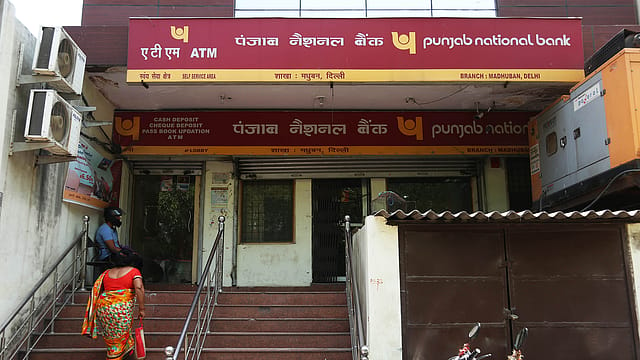PNB shares hit 52-week high; becomes third PSU bank to achieve ₹1 lakh cr mcap
ADVERTISEMENT

Punjab National Bank (PNB) continued its uptrend for the third straight session on Friday and scaled a fresh 52-week-high in intraday trade. Driven by the sustained rally, PNB became the third public sector bank to hit the ₹1 lakh crore market capitalisation (m-cap), after State Bank of India (SBI) and Bank of Baroda (BoB).
SBI, the country’s largest commercial lender, is the most valued state-owned lender with a m-cap of ₹5.58 lakh crore, while BoB is the second on the chart with a current market value of ₹1.14 lakh crore.
The market cap of PNB crossed ₹1.01 lakh crore today after the share price of the lender gained 2.1% to hit a fresh 52-week high of ₹91.81 in early trade today. The share price of PSU bank has more than doubled from its 52-week low of ₹44.41 touched on March 28, 2023.
PNB shares have outperformed the BSE Bankex index in terms of returns in the last one year. The stock has gained 53% in a year as compared to 7.6% rise in Bankex index and 13.3% growth in BSE benchmark Sensex. On the year-to-date, the counter added 60.5% as against 10.1% and 16.7% rise in the Bankex and Sensex, respectively. In the past six month, the PSU bank gained 80%, while it surged 23% in three months and 15% in a month.
December 2025
The annual Fortune 500 India list, the definitive compendium of corporate performance, is out. This year, the cumulative revenue of the Fortune 500 India companies has breached $2 trillion for the first time. Plus, find out which are the Best B-schools in India.
PNB shares have been rising for the last three sessions after CRISIL assigned ‘CRISIL AA+/Stable’ rating to tier I bonds (under Basel III) and reaffirmed its ‘CRISIL AAA/CRISIL AA+/Stable/CRISIL A1+’ ratings on the existing debt instruments of the lender.
The rating factor in consistent improvement in the bank’s underlying asset quality, expectation of strong support from the majority owner, Government of India, established market position, and its healthy resource profile.
The public sector bank registered record profit in September quarter of FY24, which was the highest in the last 14 quarters, driven by higher interest income and improvement in asset quality. In Q2 FY24, the net profit surged 327% to ₹1,756 crore, compared to ₹411.3 crore in the corresponding period last year.
The net interest income (NIIs), the difference between interest earned and interest expended, rose 20% to ₹9,923 crore in Q2 FY24, from ₹8,270.7 crore in the same period last fiscal. Total income for grew 27.7% YoY at ₹29,383 crore, while non-interest income stood at ₹3,028 crore, up 6.4% YoY.
On the asset quality front, the gross non-performing assets (GNPA) ratio improved to 6.96% from 10.48% as on September’22. Similarly, the net non-performing assets (NNPA) declined by 233 basis points on YoY basis to 1.47% from 3.80% in Q2FY23. In absolute terms, GNPA stood at ₹65,563 crore and NNPA was at ₹13,114 crore as of September 2023.
PNB’s asset quality has improved drastically from a peak of 18.4% as on March 31, 2018, primarily stemming from corporate book recoveries. Annualised slippage ratio (as defined by additions to NPA as a proportion of opening gross advances) improved to 0.8% for first half of fiscal 2024 (H1 FY24) as compared to 2.0% for FY23 and 3.3% for FY22.
Despite subdued profitability in the past, the earnings profile has been on an improving trajectory since last 6 quarters as the bank reported annualised Return on Assets (RoA) of 0.47% and 0.34% for the first and second quarters of fiscal 2024 (as compared to 0.32%, 0.18%, 0.12% and 0.09% for Q4, Q3, Q2 and Q1 of fiscal 2023).
PNB remains adequately capitalized with tier I and overall CAR (under Basel III) at 12% and 15.1%, respectively, as on September 30, 2023, compared with 12.7% and 15.5%, respectively, as on March 31, 2023. The bank’s networth coverage for net NPA improved to 7.8 times from 4.4 times as on March 31, 2023, 2.7 times as on March 31, 2021. The bank’s capitalisation has been supported by regular infusion from the central government, and CRISIL believes that PNB will be able to maintain adequate capitalisation over the medium term, backed by capital support from the centre.
The agency also opines that the recent regulation by RBI on revised risk weights on unsecured consumer loans, including credit card receivables and loans to NBFCs, is expected to have an impact on the capital ratios of the bank. However, the capitalisation levels would remain comfortable.
(DISCLAIMER: The views and opinions expressed by investment experts on fortuneindia.com are either their own or of their organisations, but not necessarily that of fortuneindia.com and its editorial team. Readers are advised to consult certified experts before taking investment decisions.)
